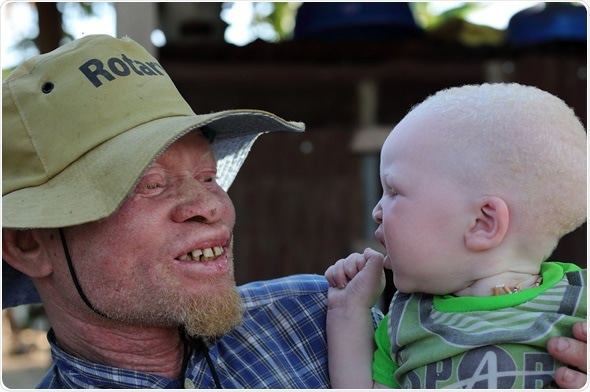Albinism is a condition marked by reduced production of melanin, the pigment that provides color to the hair, skin, and eyes of an individual. It is an inherited condition with the signs present from the birth of an infant.
Albinism is not a common condition and affects approximately 1 in 17,000 people. It can affect individuals from any racial background and, in most cases, the parents of the individual with albinism do not have physical signs of the condition.

Copyright: Dietmar Temps / Shutterstock.com
Types of Albinism
There are two main types of albinism:
- Oculocutaneous (OCA): decreased pigment in the hair, skin, and eyes.
- Ocular albinism: decreased pigment primarily in the eyes, with minimal change to the hair and skin color.
Causes
Albinism is passed on via a gene mutation from parents to children. Both parents need to be a carrier of the specific gene in order for a child to inherit most types of the condition, although they do not usually show signs of changes in pigmentation.
Inheritance follows an autosomal recessive inheritance pattern. This means that if both of the parents are carriers of the gene, each child will have:
- 25% chance of having albinism
- 50% chance of becoming a carrier of an albinism gene
- 25% chance of being unaffected by the condition
X-linked ocular albinism refers to the location of the albinism gene, which is on the X chromosome. Women have two X chromosomes and men have 1 X and 1 Y chromosome. X-linked ocular albinism is much more common in males and is passed on from women who have the gene but do not show symptoms to the son who only has one X-chromosome. If the mother is a carrier of the gene, each male child has a 50 percent chance of inheriting the condition.
Fashion model with albinism | Diandra Forrest | TEDxFultonStreet
Signs and Symptoms
Signs and symptoms of albinism may include:
- Involuntary movements of the eye (nystagmus)
- Abnormal head positions
- Misalignment of the eyes
- Sensitivity to light (photosensitivity)
- Refractive errors (e.g., hyperopia, myopia, astigmatism)
- Decrease vision due to foveal hypoplasia
- Abnormal function of the optic nerve
- Reduced or absent pigment in the iris (iris transillumination)
Treatment
Albinism is a chronic condition that remains stable over time. The production of pigment and vision development of an individual with albinism cannot be cured. However, an evaluation of the eyes and implementing management techniques can be beneficial.
For example, the use of glasses or a surgical procedure may be indicated for individuals with misalignment of the eyes, abnormal postures of the head, or involuntary eye movements. This can also help improve vision and reduce photosensitivity.
Lifestyle Modifications
People affected by albinism often have difficult coping with the symptoms of the condition, particularly visual difficulties. Long-distance vision is typically worse than short-distance and visual aids may be helpful for children to see objects far away in a classroom environment. Intelligence is unaffected by albinism, although individuals may require aids to help them see more clearly.
The lack of pigmentation in the skin also increases the risk of sunburn and skin cancer in people with albinism. For this reason, affected individuals should take care to wear adequate sun protection, including clothing, hats, sunglasses, and sunscreen.
Genetic Counseling
As albinism is an inherited condition, it is important that affected individuals and their families receive adequate information about the genetics of the disorder for future family planning. If one child is affected, additional children typically have a 25% chance of inheriting the condition. Siblings may also wish to know if they are a carrier of the gene.
References
Further Reading
Last Updated: Dec 30, 2022